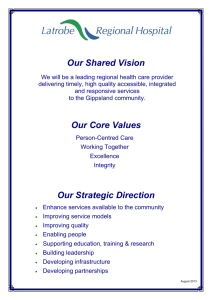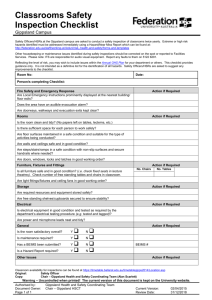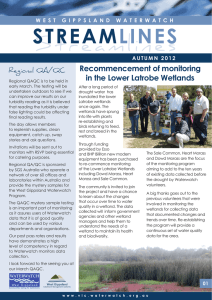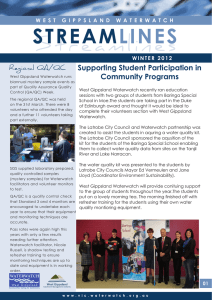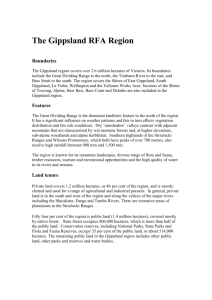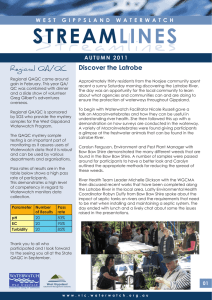Gippsland STREAMLINES Inside This Issue: Estuarine Explorers Embark
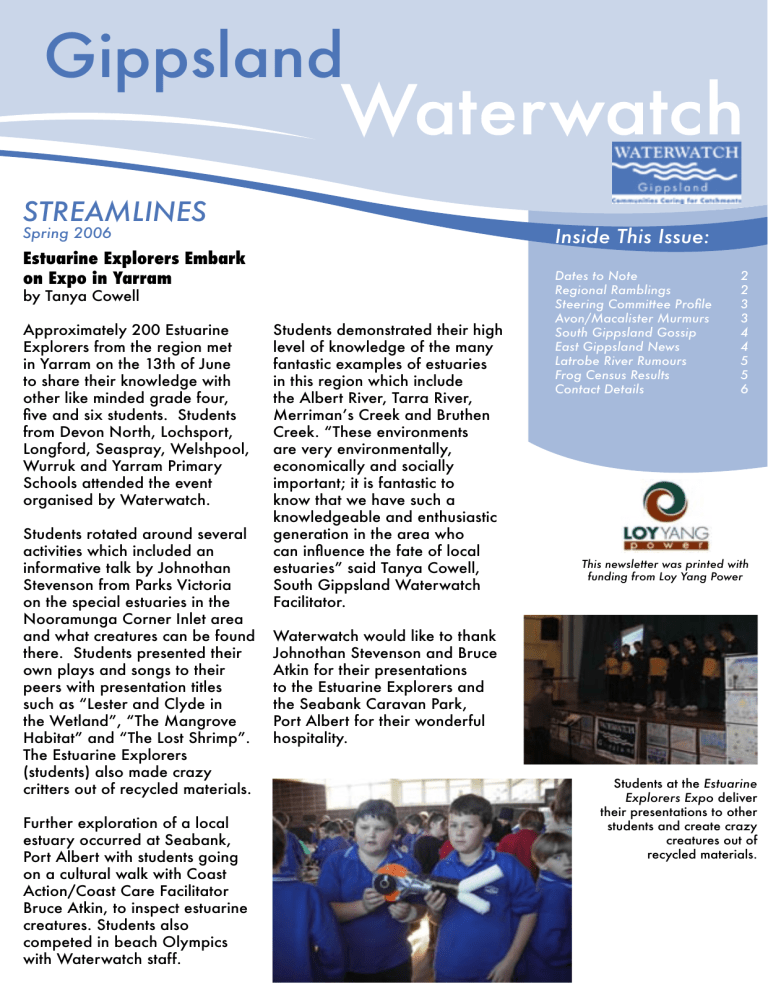
Gippsland
STREAMLINES
Spring 2006
Estuarine Explorers Embark on Expo in Yarram
by Tanya Cowell
Approximately 200 Estuarine
Explorers from the region met in Yarram on the 13th of June to share their knowledge with other like minded grade four, five and six students. Students from Devon North, Lochsport,
Longford, Seaspray, Welshpool,
Wurruk and Yarram Primary
Schools attended the event organised by Waterwatch.
Students rotated around several activities which included an informative talk by Johnothan
Stevenson from Parks Victoria on the special estuaries in the
Nooramunga Corner Inlet area and what creatures can be found there. Students presented their own plays and songs to their peers with presentation titles such as “Lester and Clyde in the Wetland”, “The Mangrove
Habitat” and “The Lost Shrimp”.
The Estuarine Explorers
(students) also made crazy critters out of recycled materials.
Students demonstrated their high level of knowledge of the many fantastic examples of estuaries in this region which include the Albert River, Tarra River,
Merrimanʼs Creek and Bruthen
Creek. “These environments are very environmentally, economically and socially important; it is fantastic to know that we have such a knowledgeable and enthusiastic generation in the area who can influence the fate of local estuaries” said Tanya Cowell,
South Gippsland Waterwatch
Facilitator.
Waterwatch would like to thank
Johnothan Stevenson and Bruce
Atkin for their presentations to the Estuarine Explorers and the Seabank Caravan Park,
Port Albert for their wonderful hospitality.
Further exploration of a local estuary occurred at Seabank,
Port Albert with students going on a cultural walk with Coast
Action/Coast Care Facilitator
Bruce Atkin, to inspect estuarine creatures. Students also competed in beach Olympics with Waterwatch staff.
Inside This Issue:
Dates to Note
Regional Ramblings
Steering Committee Profile 3
Avon/Macalister Murmurs
2
2
South Gippsland Gossip
East Gippsland News
Latrobe River Rumours
Frog Census Results
Contact Details
4
5
3
4
5
6
This newsletter was printed with funding from Loy Yang Power
Students at the Estuarine
Explorers Expo deliver their presentations to other students and create crazy creatures out of recycled materials.
Dates to Note
14th October Macalister River Canoe Tour
16th - 22nd October What YOU Can Do Enviro Roadshow
18th - 19th October National Water Week activities at Coal Creek
11th November
26th November
Tarra River Canoe Tour
Catch A Carp Fishing Competition (Lake Narracan)
Regional Ramblings by Becky Van Der Heyden & Tammy Dawson
In the East...
by Bec Van Der Heyden
(EPA/Wellington Community Consultative Committee (CCC)),
Tony Smith (EPA), Gordon Duncan (Volunteer monitor) and
David Meikle (South Gippsland CCC).
Winter is over and the fl owers and sunshine now begin!
Congratulations to everyone who participated in QA/QC week. Our pass rate was well over the State percentage pass rate for nearly every test. Just a few tips to remember, when testing the turbidity with a tube make sure that lines become blurred!
In addition to the steering committee, Waterwatch Victoria plays an important role in providing strategic guidance, merchandise, and training.
The current West Gippsland Waterwatch team consists of:
This year East Gippsland Waterwatch has made some changes to the format of the Annual Report. The water quality data collected by the volunteer monitors and the school education program are now compiled within the one report. We have also published a report card for the year, giving you a brief summary of the Annual Report and the performance of the Waterwatch program. If you would like a copy of the annual report or the report card please contact Becky.
I am currently conducting a review of the Waterwatch program, so when you receive your questionnaire from East
Gippsland Waterwatch could you please take a couple of minutes and fi ll it in and post it back.
Regional Coordinator: responsible for the management of the West Gippsland Waterwatch program across all of West
Gippsland. The Regional Coordinator reports to the West
Gippsland Waterwatch Steering Committee & the WGCMA
Partnership Development Unit Manager. This is a full time position.
Waterwatch Facilitators: responsible for coordination, facilitation and promotion of the Waterwatch program within the Latrobe, South Gippsland and Sale regions, reporting to the Regional Coordinator. Latrobe and South Gippsland positions are full time and the Sale region facilitator is employed three days per week.
We are starting to get geared up for the Spring and Summer ahead, National Water Week is fast approaching; not to mention Christmas.........
Nooramunga Corner Inlet (NCI) Project Offi cer: responsible for supporting the NCI Volunteer Project through the collection and testing of water samples and generation of data reports. The project offi cer reports to the South
Gippsland Facilitator and is employed for 20 hours per week.
In the West...
The operational structure of West Gippsland Waterwatch by Tammy Dawson
West Gippsland Catchment Management Authority
(WGCMA) acts as the lead agency for West Gippsland
Waterwatch and provides administrative support for the program. Within the WGCMA structure, Waterwatch is a member of the Partnership Development Unit.
Gippsland Lakes Education Offi cer: responsible for the integration and evaluation of Gippslandʼs Environmental
Education Resource into schools in the Gippsland Lakes catchment. Activities are coordinated between East and
West Gippsland Waterwatch with the position reporting predominantly to the West Gippsland Regional Coordinator.
Direction for the program is also taken from the Waterwatch
Steering Committee, comprising of representatives from a local water authority, WGCMA, private industry, and community members. Current committee members are,
Martin Fuller (WGCMA), Richard Appleton (Grand Ridge
Plantations), Rebecca McGuigan (Gippsland Water), Bruce
Standfi eld (South Gippsland Landcare), Jodie Halliwell
(EGCMA & WGCMA Water Quality Offi cer), Wayne Bath
East and West Gippsland Waterwatch would like to introduce our newest team member, Bruce Paton, as the
Gippsland Lakes Education Offi cer. Bruce will be contacting teachers to evaluate the use of Gippslandʼs Environmental
Education Resource which was introduced to schools last year. Thank you in advance to those teachers who partake in the evaluation.
2
Steering Committee Memeber Profile
Name of member:
Title:
Company:
Jodie Halliwell
Water Quality Officer
East and West Gippsland Catchment
Management Authorities
How long a steering committee member?
Actually been on the WW Steering committee for around 4 years, in both my current and previous roles data for many of our waterways.
As I had previously worked for
Waterwatch in West Gippsland, I feel I can contribute both a sponsors viewpoint and some understanding of how Waterwatch has evolved over time. I am also on-hand to assist with some of the more technical aspects of monitoring and interpretation of data.
Why are you a part of the committee and what is your role in the committee?
Waterwatch is a great resource for the region in terms of both education and awareness raising across a broad section of the community, and as a source of quality monitoring
Photo: Jodie Halliwell conducting Index of Stream Condition Assessments
Work Experience by Marni Speed
West Gippsland Waterwatch recently had the pleasure of having work experience student Yani Cornthwaite from Mirboo North Secondary College assisting us.
Yani worked with the Latrobe Facilitator and Frog
Census Project Officer for one week assisting with the
160 primary students at the Action in Our Catchment conference (on her first day!), creating school education materials, packaging volunteer mailouts, attending a school visit and volunteer training.
We then had to give her up to
Landcare, where she gained more skills that we hope will influence her into working with us again in the future!
Thank-you to Yani from the team!
Photo: Year 10 Mirboo North Secondary College Work Experience
Student Yarni Cornthwaite.
Avon/Macalister Murmurs by Greg Gilbert
New Monitors
Welcome to Graeme Calway who has started monitoring
Yard Creek, a tributary of the Merrimanʼs Creek.
Ann Coulson has also commenced monitoring at two sites on the lower Merrimanʼs Creek, one site has strong estuarine influence.
The Merrimanʼs Creek Valley has a graduation of dairy farming mainly in the upper region through to sheep and beef cattle grazing at the lower end.
Salt in the Streams at Rosedale
Tim, Julie and Glenn Bowman of ʻThe Ridgeʼ at Rosedale have always had an interest in the water that comes down the Central Gippsland Number 1 Drain for their property.
The drain contains water runoff from irrigation dairy farms further up the catchment in Winnindoo and Nambrok; the system also has a major groundwater bore pump, one of the earliest installed in the district. Unfortunately, this pump brings high salty groundwater down the system. In the irrigation season returning channel water dilutes the salinity in the stream; but in winter (especially in dry seasons such as this) the water is in the order of 4-5000 µS/cm. Tim has been
3 working with Southern Rural Water and the West Gippsland
Catchment Management Authority over a period of time with the aim of utilizing this source of water which is also often nutrient rich water.
Julie asked the question of Waterwatch recently, ʻWhich return drain has the highest salinity?ʼ This sent us to the
Waterwatch database to assimilate an answer. Waterwatch data from the last 10 years shows that the Gippsland
Number 1 Drain had definitely the highest mean and the highest median of 1900 and 2730 µS/cm respectively. The closest other drains to this are Number 2 and Number 3 drains (Number 3 also having a bore pump upstream), with
870 µS/cm and 770 µS/cm respectively.
While revisiting this data; it was noted that Middle Creek,
Rosedale has a mean salinity of more than 7000 µS/cm. All of these systems feed into the
Latrobe River.
Photo: Greg Gilbert, Sale WW
Coordinator chaperoned the
Woodside PS group (seen here about to head home) after the
Action in Our Catchment Day
South Gippsland Gossip by Bianca Priest
Shorebird Conservation Project
WWF-Australia
Shorebirds are among the most fascinating migratory species travelling some of the furthest distances non-stop
(over 10,000km!). Many travel a round trip of 20,000km each year between Australia and their breeding grounds in
Siberia, northern China and Alaska.
However, these birds and the habitats on which they depend are under threat from rapid economic development and population growth in east and south-east Asia.
The Gippsland region is extremely important for migratory shorebirds, with sites such as the Gippsland Lakes, Anderson
Inlet, Corner Inlet, Hazelwood Cooling Pond and Shallow
Inlet/Sandy Point supporting migratory shorebirds in internationally significant numbers.
The region is also very important for resident shorebirds
(which donʼt migrate) such as Hooded Plovers and Pied
Oystercatchers that breed on beaches. These beach nesting shorebirds are vulnerable to human disturbance, especially during the spring and summer months when they breed and raise their chicks. People and dogs on beaches frighten birds, leaving exposed eggs and chicks vulnerable to predators such as other birds and dogs, and in some instances, the cryptic eggs and chicks are crushed.
WWF-Australia with funding from the Australian
Governmentʼs Natural Heritage Trust has developed a
Shorebird Conservation Toolkit to help protect and enhance shorebird habitat across Australia. The toolkit is part of a national Shorebird Conservation Project, which has identified
West Gippsland as a priority region to support shorebird conservation efforts.
A series of talks is planned as part of the project, to raise awareness of the importance of the region to shorebirds, and how the toolkit can benefit local conservation efforts.
If your group, school or business is interested in finding out more about shorebirds, the toolkit and what you can do to help protect shorebirds please contact Bianca Priest at WWF-
Australia on bpriest@wwf.org.au or 03 6225 1394/0413
300 797.
To view the toolkit online visit www.shorebirds.org.au
East Gippsland News by Fiona Stevens
Rain, hail or shine, Schools in the Snowy River Catchment have been actively learning about their catchment throughout winter. In areas scattered around the catchment, students from Orbost Primary School, Noorinbee Primary
School, Goongerah P-8, Tubbut Primary School and Cann
River P-12 have all reported excellent results in physical and chemical water quality tests and macroinvertebrate sampling.
Aquatic bugs like macroinvertebrates are rated from tolerant, that is a level that can tolerate poor water quality through to very sensitive bugs that need excellent water quality. Students were excited to find all sorts of bugs and beasties including lots of Stonefly larvae, Mayfly nymphs,
Caddisfly larvae and dragonfly larvae – none of which are found where the water quality is degraded.
The students had fun being scientists for the day learning how macroinvertebrates can indicate water quality and I learnt that a macroinvertebrate is an animal that is visible to the eye without a backbone.
The students were amazed at the amount of aquatic bugs living in their river, we found mosquito larvae, aquatic beetles, water boatmen, water mites and dragonfly larvae.
Some of the bugs found are rated sensitive giving the Cann
River at Noorinbee an overall good water quality rating.
Students learnt all about what they can do to look after their catchment by not polluting our waterways with things like detergents, litter, grass clippings, oil, dog manure and many more.
4
Our magnificent coastline is affected by what we do in our catchment, so by reducing the amounts of pollutants entering our waterways we increase water quality and look after our coast.
The students enjoyed the Waterwatch activities and are fast on their way to becoming water quality experts!
Photos: Top right, Goongerah Primary
School identifying macroinvertebrates from the Brodribb.
Left, A student from Noorinbee
Primary school checking to see if he had caught anything.
Bottom right, Tubbut Primary School found lots of bugs and beasties in the Deddick River.
Gippsland
Latrobe River Rumours
by Marni Speed
An exciting program that Waterwatch has been involved in is a Year 9 unit at Neerim District
Secondary College called ʻPlanʼt Paddlersʼ. The unit initiated by teacher Liz Keily traces the life of the
Latrobe and the Thomson Rivers.
The students lucky enough to be involved paddle their way around both the Latrobe and Thomson River catchments, learning about river health and associated issues along the way. Relevant stakeholders from industry, community groups and NRM agencies are invited to meet the group on site to discuss topical issues.
Waterwatch have been involved in the program since itʼs inception last year and assists students by undertaking an initial training session in water quality and habitat assessment on the Latrobe River at the
Noojee Campground. With their new found skills the group set out over the semester to monitor numerous sites from upper to lower catchment, resulting in a snapshot of data to be collated and analysed at the end of the program. The unit strives to have students answer the essential question – What was, is and will be our connection with rivers?
Integrated community linked programs are becoming more popular with schools and will continue to do so with the uptake of the new curriculum VELS (Victorian
Essential Learning Standards) which encourages
Autumn Frog Census Results
Thank you to all those volunteers who participated in the first West Gippsland Frog Census this past Autumn.
The results of the census can be seen in the maps below.
The frog census pilot project has now ended and so
Philʼs time with us has come to an end. It is not all bad learning incorporating environmental sustainability and community building.
Traralgon Secondary College also has a new
Geography unit for Year 9 students focusing on the
Latrobe & Thomson Catchments. Waterwatch visited the school to talk about current river health issues before taking the students to Traralgon Creek to sample for macroinvertebrates. A very interesting flatworm entertained us all by assuming various shapes and attempting escape, (this occurred in the calm after the girls who caught it realized it was in fact a macroinvertebrate and not a personʼs severed finger!)
If any school would like the assistance of Waterwatch in developing units around water, catchments or other relevant topics, please let us know.
Photo: Neerim District
Secondary College Planʼt
Paddlers river sled their way down the Thomson River from the bridge to Cooperʼs Ck.
Photo courtesy Liz Keily.
however; Phil will continue to work with his brother,
Gerry Marantelli at the Amphibian Research Centre
(ARC) to try and spread the frog census program across the entire State.
We look forward to Philʼs return to the region in the future under his new role at the ARC.
Continued bottom next page
5
Gippsland
STREAMLINES - The Gippsland Waterwatch Newsletter
Gippsland Waterwatch Contacts:
Tammy Dawson
West Gippsland
Regional Coordinator
16 Hotham St, Traralgon 3844
Ph: (03) 5175 7800
Email: tammyd@wgcma.vic.gov.au
Marni Speed
Latrobe Facilitator
16 Hotham St, Traralgon 3844
Ph: (03) 5175 7800
Email: marnis@wgcma.vic.gov.au
Tanya Cowell
South Gippsland Facilitator
P.O. Box 99, Leongatha 3953
Ph: (03) 5662 4555
Email: tanyac@wgcma.vic.gov.au
Greg Gilbert
Sale region Facilitator
906 Dolphin Av
Golden Beach 3851
Ph: (03) 5146 3217
Email: ggil@netspace.net.au
Autumn Frog Census Results
Jill Vella
NCI Project Officer
PO Box 99, Leongatha 3953
Ph: (03) 56 624 555
Email: jillv@wgcma.vic.gov.au
Becky Van Der Heyden
East Gippsland Regional
Coordinator
PO Box 1012, Bairnsdale 3875
Ph: (03) 5150 3577
Email: bvanderheyden@egcma.com.au
Fiona Stevens
East Gippsland Facilitator
PO Box 1012, Bairnsdale 3875
Ph: (03) 5150 3578
Email: fstevens@egcma.com.au
Bruce Paton,
Gippsland Lakes
Education Officer
16 Hotham Street
Traralgon 3844
Ph (03) 5175 7800
Email: brucep@wgcma.vic.gov.au
Key Stakeholders and Sponsors
DPI/DSE
POSTAGE
PAID
TRARALGON
3844
Gippsland
